Experts at the Lawrence Livermore National Laboratory (LLNL) have recently managed to create a new class of artificial cells, which behave similarly to nerve cells inside the human brain, and which could in the future be used to create more accurate and efficient interfaces between the cortex of paralyzed patients or amputees and their aiding devices and limbs. The hybrids are made entirely out of silicon nanowires, which are enclosed and sealed in a membrane very similar to the one that surrounds the content of nerve cells, Technology Review informs.
Researchers working in the field of electronics know that the ultimate goal in communication efficiency - the ability to reach the complexity and efficacy of the connections established between living cells - is still many years away. While electronic devices relay on currents and electrical fields for communicating data, living cells also have neurotransmitters, proteins, and ions such as calcium. But the most complex device that cells have is their membrane. Made up of a double layer of lipids (fatty molecules) and large amounts of proteins, it has evolved to be the most efficient “data gate” discovered thus far.
“If you can make modern microelectronics talk to living organisms, you can make more-efficient prosthetics or new types of biosensors for medical diagnostics,” explains LLNL chemist Aleksandr Noy. He was a part of the team that created the membranes for the new nanowire devices. The scientist is also a part of a growing number of researchers who believe that if electrodes in the brain could also read chemical signals, in addition to electrical ones, then a patient's ability to wield a synthetic prosthetic device would increase considerably.
Using methods devised by other science groups, Noy created arrays of nanowire transistors, each of them about 30 nanometers in diameter. He then placed them in a microfluidic device, and used it to deliver fatty molecules to the negatively charged part of the transistor. The molecules fused together, and created a membrane that acted like that surrounding cells. When exposed to acidic or basic solutions, the sealed nanowires showed no changes, whereas unsealed ones were adversely affected.
By adding proteins to the mix, Noy was able to essentially create ion channels, similar to those that allow living cells to communicate with each other. This had the effect of making the new cells responsive to their environment - as in the chemical and electrical signals - without any harm coming to the actual nanowires inside. “The neuron is a good analog in some ways,” he says of the devices.

 14 DAY TRIAL //
14 DAY TRIAL //